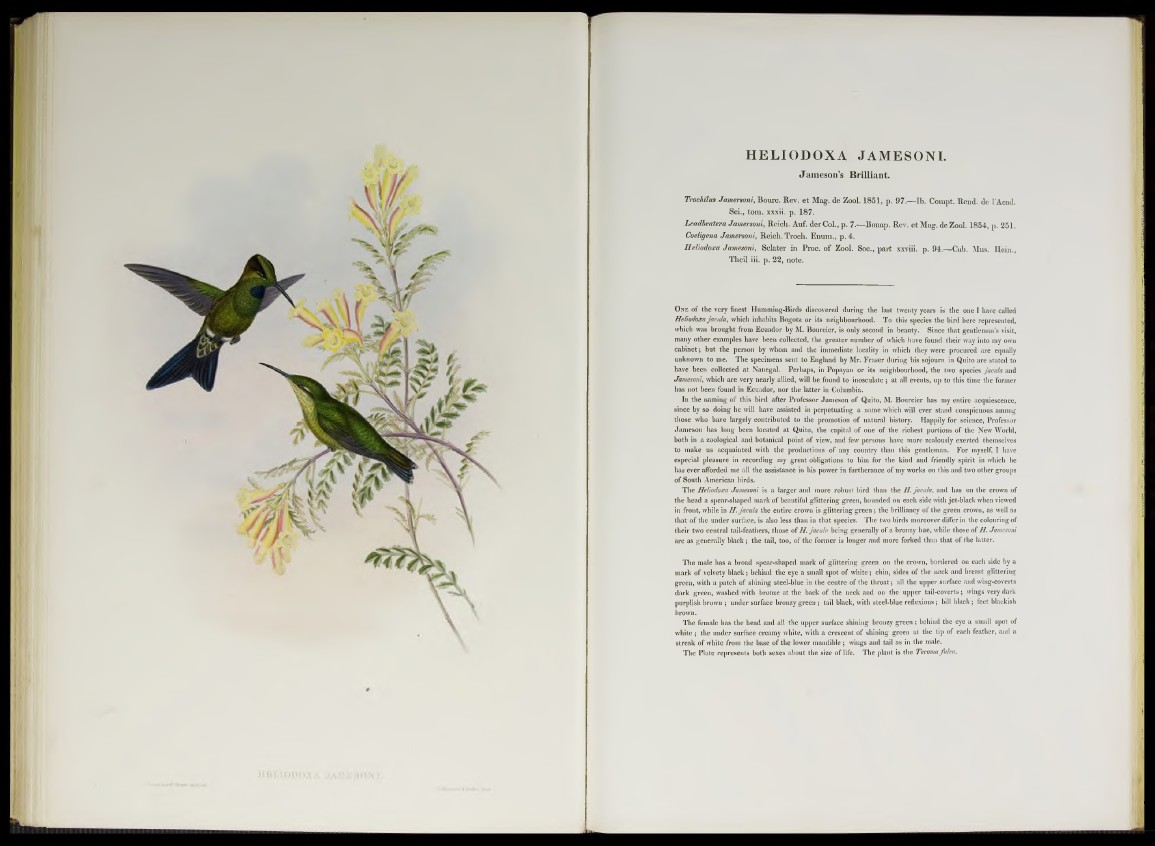
HELIODOXA JAMESONI.
Jameson’s Brilliant.
Trochilm Jamersoni, Bourc. Rev. et Mag. de Zool. 1851, p. 97.—Ib. Compt. Rend. de 1’Acad.
Sci., tom. xxxii. p. 187.
Leadbeatera Jamersoni, Reich. Auf. der Col., p. 7.—Bonap. Rev. et Mag. de Zool. 1854, p. 251.
Coeligena Jamersoni, Reich. Troch. Enum., p. 4.
Heliodoxa Jamesoni, Sclater in Proc. of Zool. Soc., part xxviii. p. 94.—Cab. Mus. Hein.,
Theil iii. p. 22, note.
On e of the very finest Humming-Birds discovered during the last twenty years is the one I have called
Heliodoxa jacula, which inhabits Bogota or its neighbourhood. To this species the bird here represented,
which was brought from Ecuador by M. Bourcier, is only second in beauty. Si nee that gentleman’s visit,
many other examples have been collected, the greater number of which have found their way into my own
cabinet; but the person by whom and the immediate locality in which they were procured are equally
unknown to me. The specimens sent to England by Mr. Fraser during his sojourn in Quito are stated to
have been collected at Nanegal. Perhaps, in Popayan or its neighbourhood, the two species jacula and
Jamesoni, which are very nearly allied, will be found to inosculate ; at all events, up to this time the former
has not been found in Ecuador, nor the latter in Columbia.
In the naming of this bird after Professor Jameson of Quito, M. Bourcier has my entire acquiescence,
since by so doing he will have assisted in perpetuating a name which will ever stand conspicuous among
those who have largely contributed to the promotion of natural history. Happily for science, Professor
Jameson has long been located at Quito, the capital of one of the richest portions of the New World,
both in a zoological and botanical point of view, and few persons have more zealously exerted themselves
to make us acquainted with the productions of any country than this gentleman. For myself, I have
especial pleasure in recording my great obligations to him for the kind and friendly spirit in which he
has ever afforded me all the assistance in his power in furtherance of my works on this and two other groups
of South American birds.
The Heliodoxa Jamesoni is a larger and more robust bird than the H jacula, and has on the crown of
the head a spear-shaped mark of beautiful glittering green, bounded on each side with jet-black when viewed
in front, while in H jacula the entire crown is glittering green; the brilliancy of the green crown, as well as
that of the under surface, is also less than in that species. The two birds moreover differ in the colouring of
their two central tail-feathers, those of H. jacula being generally of a bronzy hue, while those of H. Jamesoni
are as generally black; the tail, too, of the former is longer and more forked than that of the latter.
The male has a broad spear-shaped mark of glittering green on the crown, bordered on each side by a
mark of velvety black; behind the eye a small spot of white; chin, sides of the neck and breast glittering
green, with a patch of shining steel-blue in the centre of the throat; all the upper surface and wing-coverts
dark green, washed with bronze at the back of the neck and on the upper tail-coverts; wings very dark
purplish brown ; under surface bronzy green; tail black, with steel-blue reflexions; bill black; feet blackish
brown.
The female has the head and all the upper surface shining bronzy green; behind the eye a small spot of
white; the under surface creamy white, with a crescent of shining green at the tip of each feather, and a
streak of white from the base of the lower mandible; wings and tail as in the male.
The Plate represents both sexes about the size of life. The plant is the Tecomafilm.